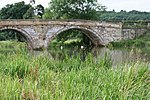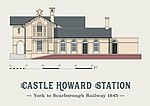Kirkham Priory
1120s establishments in EnglandAugustinian monasteries in EnglandChristian monasteries established in the 12th centuryChurch ruins in EnglandChurches in North Yorkshire ... and 8 more
English Heritage sites in North YorkshireGrade I listed churches in North YorkshireGrade I listed monasteriesGrade I listed ruinsMonasteries in North YorkshireReligious organizations established in the 1120sRuins in North YorkshireUse British English from November 2019

The ruins of Kirkham Priory are situated on the banks of the River Derwent, at Kirkham, North Yorkshire, England. The Augustinian priory was founded in the 1120s by Walter l'Espec, lord of nearby Helmsley, who also built Rievaulx Abbey. The priory was surrendered in 8 December 1539 during the Dissolution of the Monasteries. Legend has it that Kirkham was founded in remembrance of l'Espec's only son who had died nearby as a consequence of his horse being startled by a boar. The area was later used to test the D-Day landing vehicles, and was visited by Winston Churchill. The ruins are now Grade I listed and a scheduled monument in the care of English Heritage.
Excerpt from the Wikipedia article Kirkham Priory (License: CC BY-SA 3.0, Authors, Images).Kirkham Priory
Riders Lane,
Geographical coordinates (GPS) Address External links Nearby Places Show on map
Geographical coordinates (GPS)
| Latitude | Longitude |
|---|---|
| N 54.0829 ° | E -0.876675 ° |
Address
Kirkham Priory
Riders Lane
YO60 7JR
England, United Kingdom
Open on Google Maps










